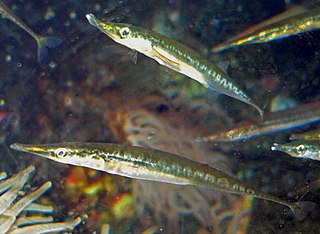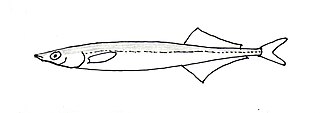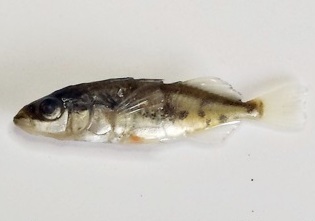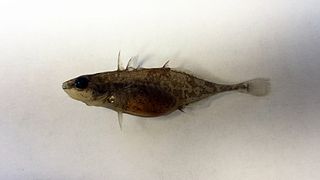
Gasterosteoidei is a suborder of ray-finned fishes that includes the sticklebacks and relatives, the 5th edition of Fishes of the World classifies this suborder within the order Scorpaeniformes.

The sticklebacks are a family of ray-finned fishes, the Gasterosteidae which have a Holarctic distribution in fresh, brackish and marine waters. They were thought to be related to the pipefish and seahorses but are now thought to be more closely related to the eelpouts and sculpins.

The three-spined stickleback is a fish native to most inland and coastal waters north of 30°N. It has long been a subject of scientific study for many reasons. It shows great morphological variation throughout its range, ideal for questions about evolution and population genetics. Many populations are anadromous and very tolerant of changes in salinity, a subject of interest to physiologists. It displays elaborate breeding behavior and it can be social making it a popular subject of inquiry in fish ethology and behavioral ecology. Its antipredator adaptations, host-parasite interactions, sensory physiology, reproductive physiology, and endocrinology have also been much studied. Facilitating these studies is the fact that the three-spined stickleback is easy to find in nature and easy to keep in aquaria.

The ninespine stickleback, also called the ten-spined stickleback, is a freshwater species of fish in the family Gasterosteidae that inhabits temperate waters. It is widely but locally distributed throughout Eurasia and North America. Despite its name, the number of spines can vary from 8 to 12.

The brook stickleback is a small freshwater fish that is distributed across the US and Canada. It grows to a length of about 2 inches. It occupies the northern part of the eastern United States, as well as the southern half of Canada. Small populations are scattered throughout the Mississippi-Great Lakes basin extending to Colorado, New Mexico, Kentucky, Tennessee, etc., though some of these areas are not native to the species. This small fish inhabits clear, cool streams and lakes. They eat small invertebrates, algae, insect larvae, and occasionally their own eggs. They are also preyed upon by smallmouth bass and northern pike. Feedin time is usually dawn and sunset. The brook stickleback does have active competition mostly from minnows, but feeding times are different, along with diet. Spawning occurs in midsummer. Males secure a territory, build a nest, and mate with females. Males provide protection for the eggs, ward off predators, and usually die later in the season. This is considered an annual species. The nests are built out of aquatic grasses. Though the brook stickleback is not considered a threatened species, deforesting and changing waters are altering ecosystems of the species. Harvesting of trees around riparian environments is having a large effect of the stream ecosystem where the brook stickleback resides.
Pungitius hellenicus, the Greek ninespine stickleback or ellinopygósteos, is a species of fish in the family Gasterosteidae. It is endemic to Greece. Its natural habitats are rivers and freshwater spring. It is threatened by habitat loss and considered critically endangered in the International Red List of IUCN, Bern Convention.

The Ukrainian stickleback also known as the Caspian ninespine stickleback, southern ninespine stickleback, and Aral ninespine stickleback, is a species of fish in the family Gasterosteidae. It is found in Afghanistan, Bulgaria, Iran, Kazakhstan, Moldova, Romania, Russia, Serbia, Montenegro, and Ukraine.

Aulorhynchus is a monospecific genus of marine ray-finned fish belonging to the family Aulorhynchidae. Its only species is the tube-snout which is found off the western coast of North America.

The Korean sandlance is a species of marine ray-finned fish belonging to the family Hypoptychidae. The Korean sandlance is the only species in this monotypic family and genus and is found in the northwestern Pacific Ocean.
Valeriy Valeryevich Zyuganov (Russian: Зюганов Валерий Валерьевич, born 31 July 1955 in Yangiyo‘l city, is a Soviet and Russian biologist, and Doctor of Biological Sciences. He is the pupil and follower of professors V.V. Khlebovich,the Zoological Institute of the Russian Academy of Sciences and Yu. A. Labas.A.N. Severtsov Institute of Ecology and Evolution of the Russian Academy of SciencesArchived 2007-12-13 at the Wayback Machine

The blackspotted stickleback is species of ray-finned fish belonging to the family Gasterosteidae, the sticklebacks. This fish is found in the western Atlantic from the coasts of Newfoundland (Canada) to Massachusetts. This is a benthopelagic species of marine and brackish waters, rarely entering freshwater, which remains near the shore. It is frequently associated with floating vegetation. The male builds a nest, in which the females deposit eggs and the male guards and aerates them. It is a small fish which reaches a maximum published total length of 7.6 cm (3.0 in), although 3.5 cm (1.4 in) is more typical. The specific name honors Richard H. Wheatland who was the Cabinet Keeper, for the Essex County Natural History Society of Salem, Massachusetts and who collected type of this species in 1859.
The Techirghiol stickleback was an endemic fish species, found in the streams inflowing to the coastal hypersaline Lake Techirghiol in southern Romania. It was a freshwater benthopelagic fish, up to 6.5 centimetres (2.6 in) SL in length. It is considered extinct due to hybridization with the three-spined stickleback following irrigation which allowed the two taxa to mix by diluting the hypersaline water barrier which separated them. The last known occurrence of the species was in the 1960s.

The smallhead stickleback, or resident threespined stickleback, is a fish species, which widespread in the basin of the Pacific Ocean: Japan, also Mexico. Freshwater demersal fish, up to 5.5 cm (2.2 in) length. Habits small streams, where feeds on aquatic insects and other invertebrates. This taxon is regarded by some authorities as a synonym of the three-spined stickleback, and others treat it as a subspecies of the three-spined stickleback, G. a. microcephalus.

Spinachia is a monospecific genus of ray-finned fish belonging to the family Gasterosteidae, the sticklebacks. The only species in the genus is Spinachia spinachia, the sea stickleback, fifteen-spined stickleback or fifteenspine stickleback, a species which lives in benthopelagic and in brackish environments of the northeastern Atlantic Ocean. This species, the largest of the sticklebacks, grows to a length of 22 centimetres (8.7 in) SL. This species is the only known member of its genus Spinachia. It is of no interest as a commercial fish.

Apeltes is a monospecific genus old ray-finned fish belonging to the family Gasterosteidae, the sticklebacks. The only species in the genus is Apeltes quadracus, the fourspine stickleback or bloody stickleback, which lives in freshwater, brackish and benthopelagic environments of the northwestern Atlantic Ocean between Newfoundland and South Carolina.

The Icelandic threespine stickleback is a freshwater fish, and one of the few vertebrate species endemic to Iceland. In some literature it is considered as a subspecies of G. aculeatus, though several authorities offer it full species status. It was first described by French biologist Henri Émile Sauvage in 1874.

Pungitius laevis, commonly known as smoothtail ninespine stickleback, is a species of freshwater fish of the family Gasterosteidae. It is distributed in temperate brackish benthopelagic waters of coastal western Europe.
Gasterosteus nipponicus is a species of ray-finned fish belonging to the family Gasterosteidae, the sticklebacks. This species is found in the northwestern Pacific Ocean.













